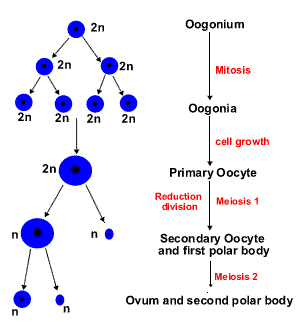1
Question
State whether the following statements are true or false .
During oogenesis, one primary oocyte gives rise to four ova.
State whether the following statements are true or false .
During oogenesis, one primary oocyte gives rise to four ova.
Open in App
Solution
The correct option is B False
In females, the total number of eggs ever to be produced are present in the newborn female initially arrested at the diplotene stage of the meiosis I from fetal life through childhood until puberty, when the lutenizing hormone (LH) surges stimulate the resumption of meiosis.- All eggs are arrested at the prophase I of the first meiotic division as a primary oocyte.
- Following puberty, during each menstrual cycle, pituitary gonadotrophin stimulates completion of meiosis 1 the day before ovulation.
- In meiosis 1, a diploid cell becomes 2 haploid (23 chromosomes) daughter cells, each chromosome has two chromatids.
- One cell becomes the secondary oocyte while the other cell forms the first polar body.
- The secondary oocyte then commences meiosis 2 which arrests at metaphase and will not continue without fertilization.
- At fertilization meiosis 2 completes thus forming a second polar body.
- So it is clear that each oogonia after complete maturation gives rise to one ovum.

So the correct option is 'False'.
In females, the total number of eggs ever to be produced are present in the newborn female initially arrested at the diplotene stage of the meiosis I from fetal life through childhood until puberty, when the lutenizing hormone (LH) surges stimulate the resumption of meiosis.
- All eggs are arrested at the prophase I of the first meiotic division as a primary oocyte.
- Following puberty, during each menstrual cycle, pituitary gonadotrophin stimulates completion of meiosis 1 the day before ovulation.
- In meiosis 1, a diploid cell becomes 2 haploid (23 chromosomes) daughter cells, each chromosome has two chromatids.
- One cell becomes the secondary oocyte while the other cell forms the first polar body.
- The secondary oocyte then commences meiosis 2 which arrests at metaphase and will not continue without fertilization.
- At fertilization meiosis 2 completes thus forming a second polar body.
- So it is clear that each oogonia after complete maturation gives rise to one ovum.

So the correct option is 'False'.
Suggest Corrections
0
View More
Join BYJU'S Learning Program
Join BYJU'S Learning Program
